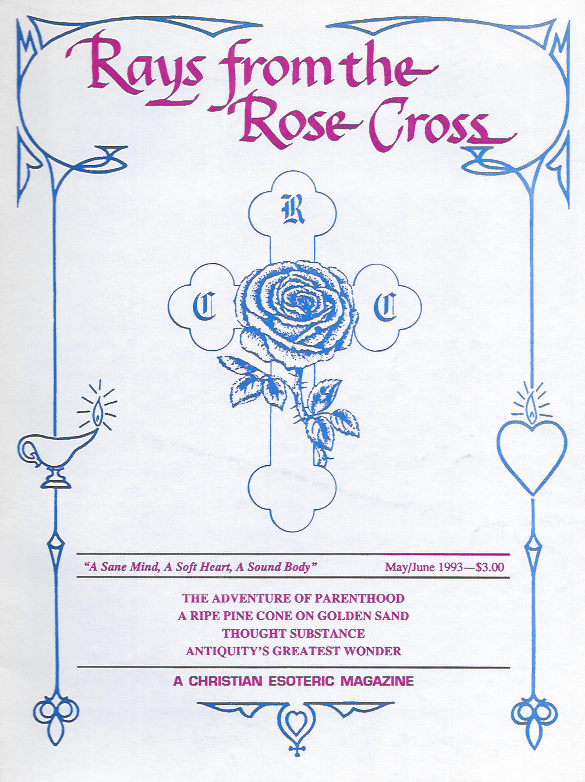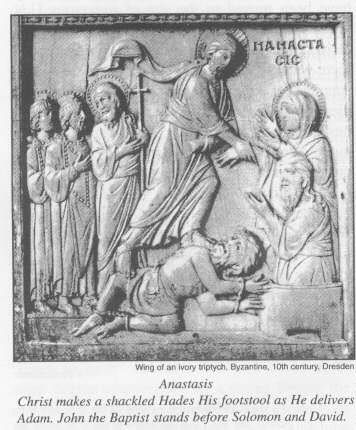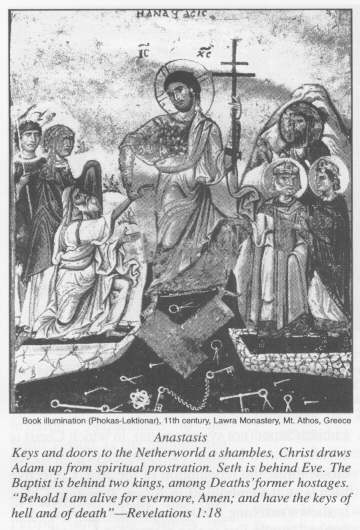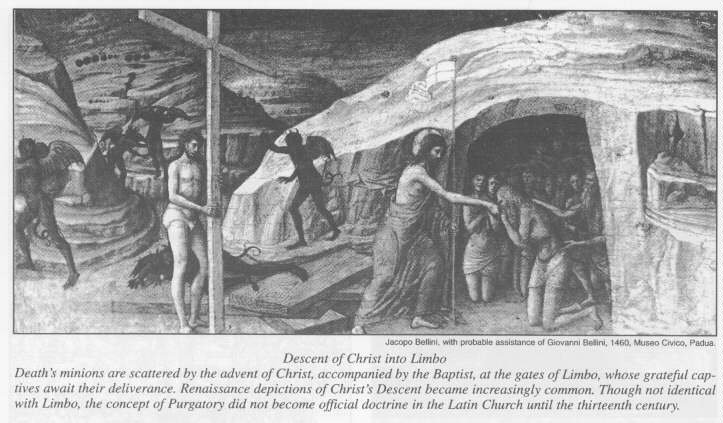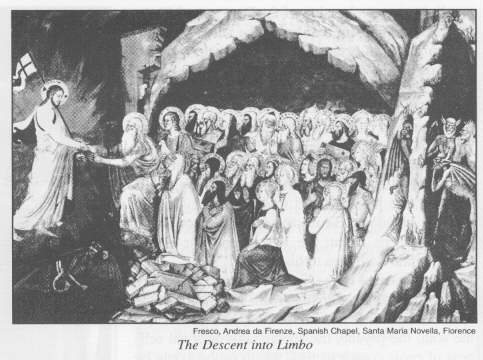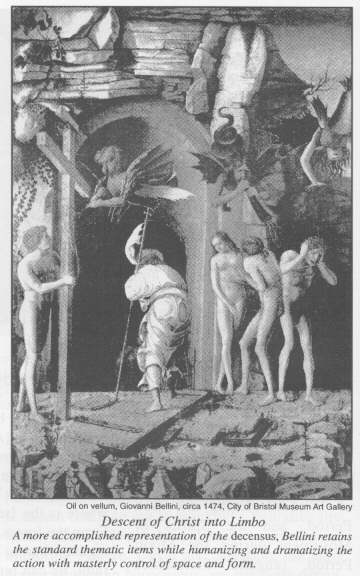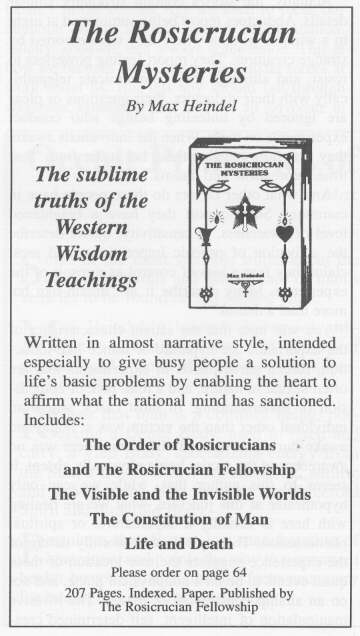Rays From The
Rose Cross Magazine
Religion and Art
The Resurrected
Christ in the
Realm of the Dead
Students of mystic Christianity know that Christ Jesus designates
the Archangelic Christ Being Who lived for three years as Ego
in the human vehicles of the man Jesus. While the Roman Catholic
Church has tended to emphasize the humanity of Christ Jesus, the
man of sorrows acquainted with grief, the crucified God, the Orthodox
Catholic Church emphasizes the divinity of Christ, particularly
as seen in the Resurrection. This same contrast is evident in
the Western Church's presentation of Mary as the Mater Dolorosa
(Mother of Sorrows) versus the Eastern Church's hieratic Mary
as Theotokis (Mother of God).
In fact, the Victorious Christ is the ritual, liturgical icon
for Eastern Orthodox Church's celebration of Easter. In itself,
this is hardly surprising. But the pictorial content of the icon
is. For it shows not an empty tomb, or even Christ appearing to
the disciples, but a Christ in the Underworld, appearing to the
dead. What is the basis for such a portrayal?
For the apostle Paul, "If Christ has not been raised, then
all our preaching is in vain." Saul, before his time, saw
the Risen Christ and thereby knew that the man Jesus, whose followers
he had sought with such fury to silence, was the Messiah, the
Son of God. He also knew that as Messiah (he who saves), humanity
had a deliverer from "this body of death" (Rom. 7:24).
Paul knew that "Christ, being raised from the dead ['by the
glory of the Father'] dieth no more, death hath no more dominion
over him" (Rom 6:9), and, as such, was the "first born
among many brethren" (Rom 8:29). Who then was to be raised?
Those yet living and those yet to be born? Indeed. But also and
especially them who had lived and were now death's thralls, who
had been "waiting for the adoption, to wit, the redemption
of our body" (Rom. 8:23).
Where were these dead? In the Netherworld. How held? By Satan
and Hades. In what form held? Surely not as mineral bodies? No,
but as the essential physical Form that had been tainted by Original
Sin, by the loss of an original power and purity that caused them
to sleep, Christ being the "first fruits of them that slept"
(1 Cor. l5:20). How were they liberated? Paul tells us in Ephesians
(4:9) that before He ascended, Christ "descended first into
the lower parts of the earth" where, releasing them from
death's dominion, "he led captivity captive" (4:8).
The ancient Eastern text (Peshitta) is more suggestive of the
spiritual nature of Christ's deed. It says "Now that he ascended,
what is it but that he also descended first into the inner parts
of the earth." Max Heindel also refers to this initiatory
event with respect to Jesus, who, as "the son of Seth, entered
the Subterranean strata where he remained for some time in communion
with the spirits who dwell there" (Freemasonry and Catholicism,
pp. 82-83).
Christ came to seek and save that which was lost. To do so, the
living blood of Jesus had to flow into the earth. When the blood
flowed from the six wounds (etheric centers), "the great
Sun-Spirit Christ was liberated from the physical vehicles of
Jesus and found Himself in the Earth with individual vehicles"
(Cosmo) with which He permeated the
already existing planetary
vehicles, flooding the Netherworld with light and radiant energy,
thereby rendering impotent "him that had the power of death,
that is, the devil" (Heb. 2:14). How could this be? The human
dense physical body still dies. True, but not the essential physical
Form, the handiwork of three and one-half incarnations of Earth.
What was the Scriptural justification for this dramatic action?
The promise to David is fulfilled: "Lord, thou hast brought
up my soul from the grave" (Psalm 107); "For he hath
broken the gates of brass and cut the bars of iron in sunder."
Peter exclaims, after the descent of the Holy Spirit on Pentecost,
that now his flesh rested in hope "because thou wilt not
leave my soul in hell" (Acts 2:27).
Also, in l Peter 4:6, the apostle tells his brethren that the
gospel was preached to the dead. Elsewhere (1 Pet. 3:19) he writes
that Christ "preached unto the spirits in prison." So
also was the word of Ezekiel (37) fulfilled: "Behold I will
open your graves and cause you to come up out of your graves and
bring you into the land of Israel." Paul's statement in l
Cor. l5:13, "But if there be no resurrection of the dead,
then is Christ not risen," had already been established by
Matthew (27:52-53): "The graves were opened: and many bodies
of the saints which slept arose, and came out of the graves after
his resurrection, and went into the holy city and appeared unto
many."
The pictorial ingredients for the generic human resurrection were
provided by the Gospel of Nicodemus (formerly called The Acts
of Pontius Pilate), a third century document. Here, the King of
Glory "broke asunder the fetters which could not be broken"
and released "the captives that were held in chains by original
sin and bringest them into their former liberty," raising
the human body of Adam, the father of mankind, with all the patriarchs
and prophets. Seth is specifically mentioned, as are David and
John the Baptist, who again is the "forerunner," in
this instance announcing the descent of Christ to Hades. Satan
(Lucifer) is addressed by Hades, "O prince Satan, all thy
advantages which thou dids't acquire by the forbidden tree and
the loss of Paradise, thou hast now lost by the wood of the cross."
These representations of the descensus ad inferno have three aspects:
one, a proclamation of the Gospel to the ancestors (Christ is
often shown carrying a scroll); two, the victory over Hades-Lucifer/Satan
(not synonymous), in which Christ is usually shown bearing the
emblem of power, the cross; three, the redemption of the Just.
Collective humanity is symbolized in Adam, therefore Christ is
shown reaching out to mankind's figurative first father. Usually
Eve is also pictured in a grateful and imploring gesture. David
and Solomon, the latter not mentioned in Nicodemus, are normally
depicted wearing crowns. Christ is often shown with a foot on
the overpowered Hades, or, alternately, angels subdue and bind
the one who formerly bound. Paul promises the Romans (16:20),
"the God of peace shall bruise Satan under your feet."
These portrayals are called anastases (ana-up + stasis-stand)
because they show Christ empowering the dead to stand up, to arise,
indeed, to resurrect. As Christ is "the firstborn from the
dead" (Col. 1:18), those whom He first rescued are known
as protoplasts, the "first-formed," being Adam and Eve
and their descendants. This is, in truth, a kind of second Creation
of Man.
How could a semi-apocryphal doctrine become elevated to an official
festival representation? Because it satisfied the intuition of
a deep need and a fundamental truth: With Adam a God-given capability
had become compromised, and through Christ Jesus that endowment
was redeemed and restored.
At death certain physical forces and all mineral substances are
dispersed. But these do not constitute the essential human body.
They but complete or flesh out its configuration. The Form of
the body as a spiritual texture works up the substances and forces
so they fill out the human physical body. What is passed over
from one incarnation to the next is the essence of the physical
body, its Form as contained in the forces of the seed atom-truly
a micro-microcosm.
As originally created, the Form of the human body was a transparent
body of force. It was invisible, bequeathed to the Earth Period
as the culmination of the work of the Thrones during the Saturn
Period, the Spirits of Wisdom during the Sun Period, and the Spirits
of Movement during the Moon Period (angelic hierarchies corellated
with the constellations of Leo, Virgo, and Libra, respectively).
Only during the Earth Period did the Spirits of Form (Scorpio)
instill in man this real Form, also called the Phantom.
But by the illicit entry of the Lucifer Spirits, this original
network of invisible forces was compelled to take in dense matter.
When the Lucifers were thrown down, they, in a sense, took humanity
with them. As colored pigments stain clear glass, making it visible,
so did the Lucifer influence stain the clear fleshless human Form,
opaque. Or, as Paul expresses it, the human body became corruptible.
Christ Jesus, "who has the keys of hell and of death"
(Rev. 1:18), reinstates the body's spiritual genealogy that should
have been bequeathed by Adam. The anastases depict the effect
of this repossession. In them Christ Jesus steps on the head of
Lucifer-Hades, fulfilling the curse of Jehovah to the Serpent
that mankind shall bruise its head (Gen. 3:15). Whereupon Paul
may say, appropriately, "Oh death, where is thy [serpent-dealt]
sting, oh grave, where is thy victory?" From the forces that
rose from the grave of Christ Jesus mankind can regain what he
has lost. What had become increasingly feeble and faint, he can
regenerate through Christ and be clothed upon as was the first
Adam clothed before being clad with his coats of skins.
It is truly a Risen Body, not flesh and blood, not the corruptible,
earthly body, but yet physical-the quintessence of Earth evolution,
the alchemical quiddity, an incorruptible body, the gift of spiritual
Hierarchies focused in the Christ, the Second Adam, imparted to
anyone who enters into a true and whole relationship with Him.
Ego consciousness could not have advanced had Golgotha not taken
place. Rather would it have become dimmer and dimmer, eventually
being blotted out altogether. But now is Lucifer cast out of the
Garden. Christ gave His Body truly. He broke the Bread of His
Body that ours might be made whole. With Christ there rose out
of the grave a seed-kernel for the reconstruction of the human
physical Form, the Resurrection Body. It is this fact that Holy
Communion celebrates, the living proof that matter is not merely
matter, but that the Being of Christ as Spirit can unite with
it.
The earth took in the body of Jesus transformed by the Christ
as planetary communion. Henceforth, Christ is present to them
who seek Him, the Spirit in matter by which they may rise in Ego
consciousness to a living comprehension of the Presence of Christ
in the earth (as Paul realized). The earthly, flawed human form
has been trans-formed by the flawless Form of Christ in Jesus.
The Eastern Church's Easter picture is not an empty sepulcher.
This scene of hope mingled with bewilderment may suggest Resurrection.
But where is the Resurrected, the Overcomer? He is resurrecting
fallen, indeed, prostrate and sleeping, humanity. He has burst
asunder the "brass gates of cruelty"; He has rendered
useless the keys to an infernal kingdom; He has made the captor
Death captive to His Light; He has taken "our earthy father
Adam with him to his glory."
The prospect of losing his soul in limbo was a very real concern
to pre-Christian man. He knew that the spirit is eternal and returned
to God Who gave it. But the soul, the psyche, the specifically
personal selfness of egoic consciousness, which evolves only by
being in the physical body, could be lost, so that the possibility
of a spirit incarnating in bodies as automata, soulless, not even
knowing or experiencing the loss of their humanity, was a real
danger.
But the Christian Easter Mystery evokes a completely different
vision and feeling through the Resurrected Christ, Him over whom
Death has no dominion. Humans have become able to unite spiritually
so that their soul loses its power to corrupt the body. For as
Paul recognized and explained to King Agrippa, Moses prophesied
that Christ Jesus was the first to rise from the dead (Acts 26:23).
Of course Moses knew that every spirit must rise. But their bodies,
until Christ, the Deliverer, were captive to Death. So may Timothy
refer to "Our Saviour Jesus Christ, who hath abolished death"
(2 Tim. 1:10)-not death itself, but its power to keep back or
deny something not of death (Heb. 2:14). Thus may St. John call
the body of Jesus "the first begotten of the dead" (Rev.
1:5) by the power of Christ.
Four of the twelve articles of faith articulated by the Christian
Community, an ecclesiastical movement founded within the Anthroposophical
Society, are instructive. They shed light on Christ's inner-Earth
work even as they correlate with both the original Apostle's Creed
and the twelve signs of the zodiac:
5. The Christ Jesus suffered under Pontius Pilate the death of
the cross and was lowered into the grave of the earth.
6. In death He became the Helper of the souls of the dead who
had lost their divine nature.
7. He overcame death, after three days.
8. Since that time He is the Lord of the heavenly forces upon
earth and lives the Fulfiller of the deeds of the Father, the
Ground of the World.
All that humanity has lost since the Fall can be gradually recovered.
That is why the Mystery of Golgotha must be regarded as the central
point in human evolution. And because of this Event mankind shall,
by the conclusion of Earth evolution, be in possession of immortal
physical bodies. In this light we are to understand Christ's words
from the Cross: "It is finished." The corrupting power
of the soul is now a thing of the past. The Christ Impulse was
necessary in order that the end of Earth evolution should be worthy
of the beginning.
Before Christ became Earth's indwelling Spirit, the grave was
a tomb. Now it is a womb from which the Christ "body"
is put on. Through the Resurrection the Form of the physical body,
the work of the Gods, through our Lord Christ, is restored to
humanity as the now incorruptible fruit of Earth evolution.
"Hades seized a body, and lo! it discovered God; it seized
earth, and, behold! it encountered heaven; it seized the visible,
and was overcome by the invisible. O death, where is your sting?
O Hades, where is your victory? Christ is risen and you are abolished....Christ
is risen and life is freed" (St. John Chrysostom).
— C.W.
— Rays from the Rose Cross Magazine, March/April, 1996
This web page has been edited and/or excerpted from reference material, has been modified from its original version, and is in conformance with the web host's Members Terms & Conditions. This website is offered to the public by students of The Rosicrucian Teachings, and has no official affiliation with any organization.
